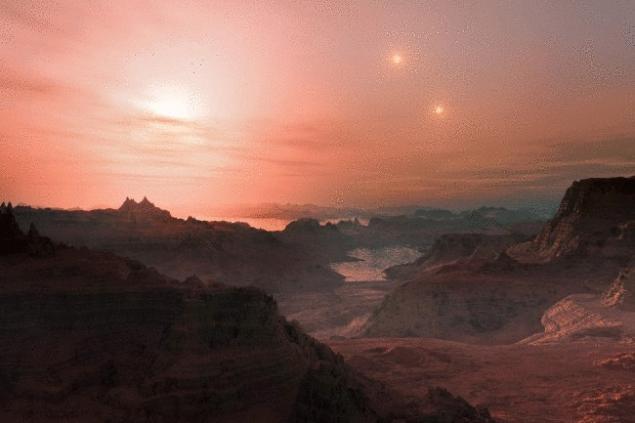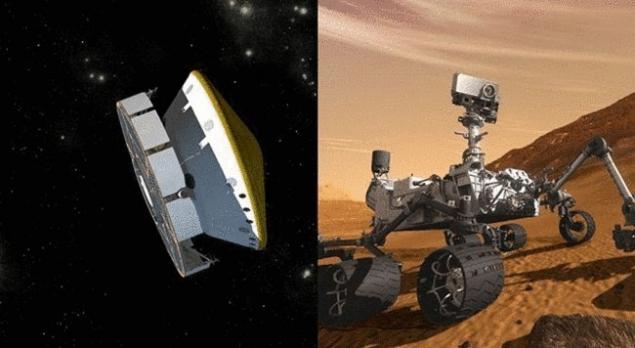Information theory: a new way to search for life that is not similar to our
 Bashny.Net
Bashny.Net

In our galaxy there are more than two dozen exoplanets, which can be a potential life, not to mention the numerous other inhabited worlds, which can be in the hundreds of billions of other galaxies throughout the Universe. Given these numbers, the chances of existence of life beyond Earth is very high, but the chances of finding that life is much lower.
Why? For a start we just don't know how it will look like alien life.
"It may be so different that we are even looking into her eyes, know what is life," says Christoph Adami, Professor of Microbiology and molecular genetics at the University of Michigan.Life without carbon

The sea Ligeia, possible storage life on Titan
The basis of all life on Earth is carbon, this means that the molecules that make up every known organism, contain carbon atoms linked with other atoms. Life on Earth also depends on the oxygen: plants take carbon dioxide (a carbon and two atoms of oxygen) and give oxygen which people need for life-saving breath.
But other life forms may be based on something completely different. A good example is a simple organic compound methane is one atom of carbon and four of hydrogen. Take, for example, the moon of Saturn the Titan. This moon is rich in lakes of liquid methane on the surface, and the oxygen level is extremely low — people would not be able to survive there. But these lakes can store life form based on methane, and they will be extremely different from the life we have here on Earth.
The problem is that our tools for detecting life are designed to search for life similar to ours, so we can never know if the Titan or anywhere else in other worlds life on the other chemistry.
Adami working on a way to solve this problem. He presented his approach at the meeting of the American physical society in April in Baltimore. In the early 90s, he participated in the development of a complex computer program called Avida. This program explores how digital organisms — computer programs with the ability of self-replication and mutation without human intervention — evolyutsioniruet over time. Scientists use similar programs to better understand the aspects that drive Darwinian evolution. Their artificial process of self-replication — a great analogy of real life on Earth.
However, Adami had big plans for Avida.
He's looking for a sign that will have all life in the Universe — a universal theme that will go beyond the chemicals of which life is composed. If this universal topic there is, and we know how to define it and to check, we can quickly identify other moon for the existence of life, even if it will have a completely different chemistry.
Adami thinks that is quite close to the discovery of this theme.
"There are things that are universal to all forms of life everywhere, for example, information. Information is, in fact, what allows you to make predictions. All living systems have to do." This information is stored in the genome of each organism is the complete set of their genes. A good way to provide this information to think about as separate pieces, or bits, like the bits in our computers. One chain of human DNA, for example, may contain hundreds of millions of these "bits" of information, says Adami. And how develops the body, he says, depends on how these bits are reproduced and mutated over time.
In one of the lectures of the famous astrophysicist Stephen Hawking says that the information in our DNA "probably changed by only a few million bits" over the last few million years of our evolution from monkeys. Of course, Hawking — astrophysicist, not an evolutionary biologist, so his theory can be divided in two. But he's not the only one who thinks that evolution is due to changes in the information bits of our genomes.
The big question

The big question is how to distinguish information that is stored in the molecules of living organisms from that stored in inanimate objects. One way is to observe patterns, templates, order, says Adami.
Unlike living creatures, which generate specific patterns as reproduction and self-reproduction (similar to how repeat itself, the sequence of our DNA), inanimate things will only have random bits of information that will never be repeated with a certain frequency.
So, the task: find a repeating sequence.
Unfortunately, that's easier said than done.
The best way, according to Adami, will look for chemical substances in the soils of other moons and planets in our Solar system. Anybody yet did not. On Board the Rovers NASA has no instruments, using the method of Adami, also we have Rovers on other planets and moons yet. And although the discovery of extraterrestrial life in the soils of other worlds can happen very soon, scientists on Earth are still the hunt for life forms that have not yet been discovered. One approach is a very promising option.
In November 2014, scientists of the joint genome Institute (JGT) has proposed an experiment that could find a fourth domain of life on Earth. At the moment there are only three domains. Is archaea, bacteria and eukaryotes. Every domain has a specific sequence at gene structure, RNA that distinguishes it from the other two groups.
However, the JGT team suspects may be a fourth domain with a brand new sequence of RNA, which still has not been seen.
"We are ready, armed with a new Toolkit of powerful genomic technologies to generate and extract large amounts of data to discover that a new life can be strikingly different from what we have in the directory at this moment," said JGI Director eddy Rubin. To do this, the team wants to look at the genes of the cells of a tiny forms of life that existed more than 2.3 billion years ago, when the Earth was much less oxygen than today. Nizkokalorina conditions in those times may have stimulated the emergence of a genetically unique life form, which may be similar to life forms on other worlds, where there is little oxygen in the atmosphere, like Mars. This interesting form of life — a kind of "dark matter" in biology.
You will find it on Earth or in another world, this discovery is incredible. You only have to find. published
Source: hi-news.ru
Tags
See also
The theory of information transmission from the future himself
Harmony time — the theory of the 4 Ashrams of life
The search for extraterrestrial life must begin with questions of life and death
New first aid kit: life saving becomes more effective
ExoLance: kraudfandingovy project to find life on Mars under the surface of the planet from NASA veterans
7 strange questions, which can help you find the meaning of LIFE
Scientists have proposed a new way to search for aliens
Forget the cemetery: in Italy came up with a new way of burial!
Forget Cemeteries: Completely New Way Burial already invented!
How to heal the true causes of laziness
















